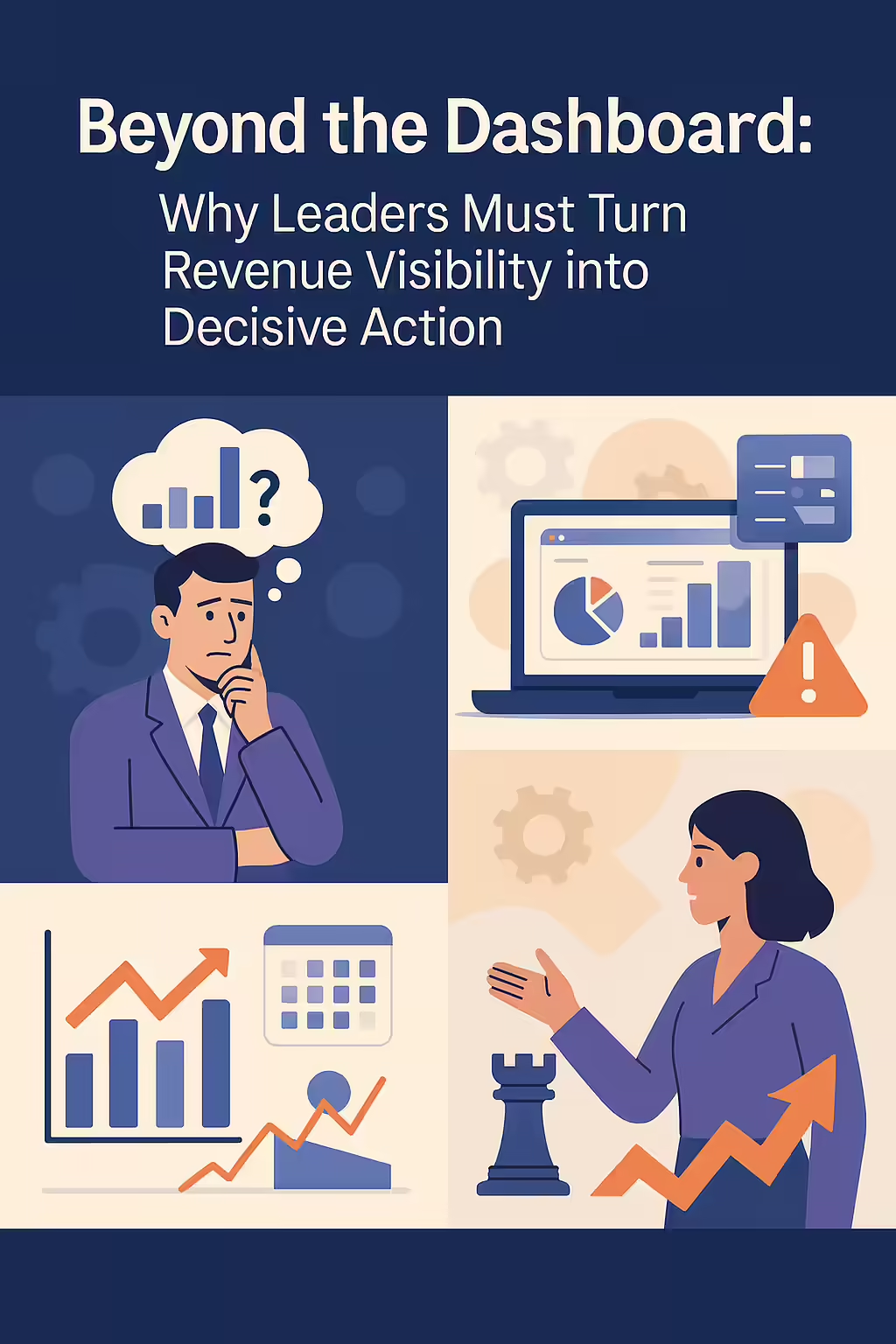In the modern business landscape, revenue leaders are under relentless pressure. They face demanding boards, ambitious growth targets, and a competitive environment that evolves at an astonishing pace. For a Chief Revenue Officer or VP of Sales preparing for a critical board meeting, the most pressing question is often the most fundamental: “Will we hit our number?” The stakes are immense; revenue is a company’s most visible and vital metric, and a single missed quarter can have cascading consequences for shareholder value and job security.
This pressure has given rise to a profound leadership paradox. Companies have invested heavily in a sprawling ecosystem of SaaS platforms, CRMs, and analytics tools, generating more data than ever before. Yet, leaders often find themselves flying blind. A staggering 58% of business leaders admit to making decisions based on outdated or incomplete data. This is not a minor inconvenience; it is a critical operational vulnerability. The explosion of tools has led to an explosion of fragmented information, burying critical insights across disconnected systems and communication channels. The result is a state of “productivity paranoia,” where leaders lack real-time clarity and decision-making slows to a crawl, mired in guesswork and manual data wrangling.
The solution is not another dashboard or a more complex spreadsheet. It is a fundamental strategic shift from passive data collection to active Revenue Orchestration. This new paradigm moves beyond simply viewing data to orchestrating data-driven actions across the entire go-to-market team. This analysis will demonstrate how leaders can escape the visibility crisis, transforming fragmented data into a unified engine for decisive action that creates predictable growth, scales winning behaviors, and delivers a measurable return on investment.
The Modern Visibility Crisis: More Data, Less Clarity
The core challenge for today’s leadership is not a lack of data, but a lack of coherent, actionable intelligence. The very tools meant to empower have inadvertently created a complex web of information silos, leading to a crisis of visibility that directly impacts revenue performance. This crisis stems from systemic issues in how technology, people, and processes interact within the typical go-to-market organization.

The Fragmented Tech Stack – The “Point Solution Puzzle”
The modern revenue organization often operates on a collection of disparate technologies. Sales uses a CRM and a sales engagement tool, marketing has its automation platform and analytics suite, and customer success relies on a separate helpdesk or management system. While each tool may be effective for its specific function, they rarely communicate seamlessly, creating what Forrester analysts call the “Point Solution Puzzle”. This fragmentation results in deep, functional data silos where valuable information is compartmentalized and inaccessible to other teams who could benefit from it.
To get a complete picture of the customer journey or the health of the pipeline, a leader must manually piece together information from CRM records, Excel spreadsheets, Slack threads, and email recaps. Each source may hold a different version of the truth, making it nearly impossible to establish a single, reliable view of the business. This manual aggregation is not only inefficient but also highly prone to error, leaving leadership to make high-stakes decisions based on a patchwork of potentially conflicting data points.
The Consequences of Poor Visibility for Leadership
This lack of a unified view has severe, tangible consequences that resonate directly with a leader’s primary responsibilities and pressures.
Inaccurate Forecasting & Missed Targets: When real-time, holistic data is unavailable, forecasting devolves into an art form based on rep sentiment and manually updated CRM fields, which are often outdated or inaccurate. Leaders are forced to rely on guesswork rather than a data-driven understanding of deal health and pipeline velocity. Given that revenue is the lifeblood of any company and its most scrutinized metric, the inability to forecast accurately is a profound liability that can erode credibility and trigger alarm bells across the organization.
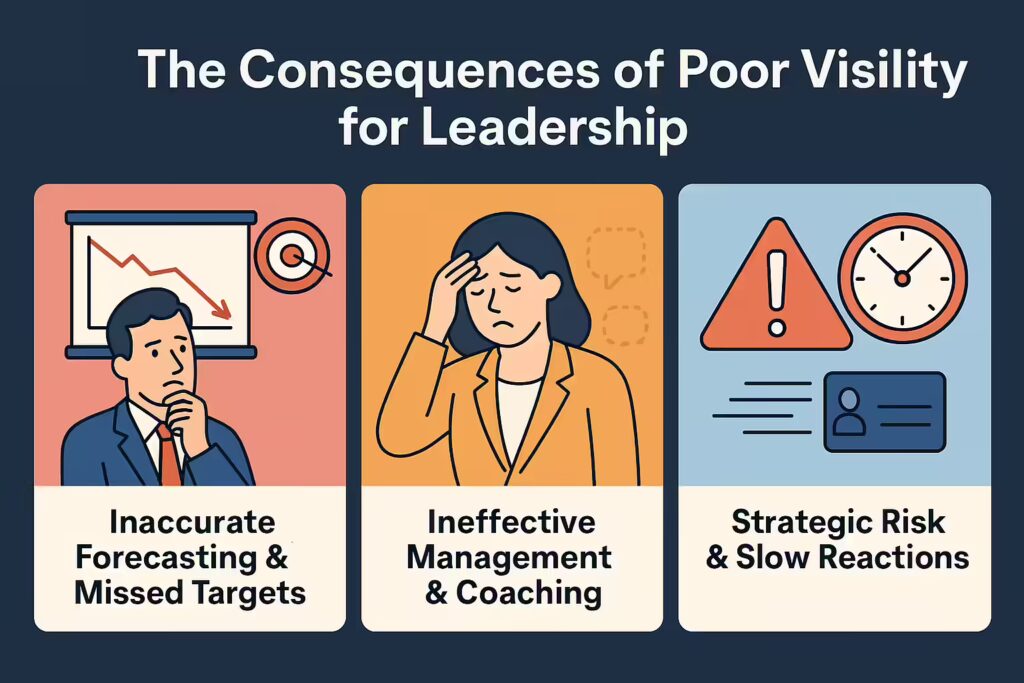
Ineffective Management & Coaching: A leader cannot effectively manage or coach what they cannot see. Without clear visibility into the day-to-day activities and conversations of their teams, managers struggle to understand why some reps consistently outperform others. They are left to coach based on anecdotes and lagging indicators rather than on the specific behaviors that drive success. While research shows that consistent coaching is directly tied to higher quota attainment, it is also incredibly time-consuming. Poor visibility makes this essential task even more difficult, preventing leaders from identifying and scaling the best practices of their top performers across the entire team.
Strategic Risk & Slow Reactions: The visibility crisis is, at its core, a strategic risk. When 55% of CFOs report lacking the visibility into core business data needed for strategic guidance, the organization’s ability to plan and adapt is fundamentally compromised. Decisions are delayed while teams scramble to gather information, critical problems are identified too late to be effectively addressed, and the business loses its agility in a fast-paced market. This reactive posture, born from a lack of real-time clarity, puts the company at a significant competitive disadvantage.
The Reporting Trap: The Illusion of Control
To compensate for this chronic lack of visibility, organizations inevitably fall into what can be called “The Reporting Trap”. Leaders demand more reports, and teams dedicate an enormous amount of time and effort to manually creating them. One study found that small businesses spend an average of 180 hours per year simply updating reports. This frantic activity creates an illusion of control and data-driven management, but it’s a facade. The data in these reports is often stale the moment it is compiled, representing a snapshot of the past rather than a real-time view of the present.
This entire process creates a self-perpetuating negative feedback loop that drains resources and stifles growth. The fragmented data leads to poor visibility, which in turn causes inaccurate forecasts and missed targets. The pressure from these missed targets compels leadership to demand more data, forcing teams to spend valuable time on manual, low-value reporting. This time spent on reporting is time taken away from high-value, revenue-generating activities like selling and strategic coaching. This reduction in productive activity further degrades performance, leading to more missed targets and an even more desperate call for data, restarting and intensifying the vicious cycle. Breaking this cycle requires moving beyond the trap of manual reporting to a system that automates data capture and provides real-time, unified intelligence.
The Paradigm Shift: From Data Management to Revenue Orchestration
Escaping the visibility crisis requires more than just a better tool; it demands a new strategic philosophy for running a go-to-market organization. This new paradigm is Revenue Orchestration. It represents a fundamental shift away from disconnected data management and toward the active, intelligent coordination of all revenue-generating activities.
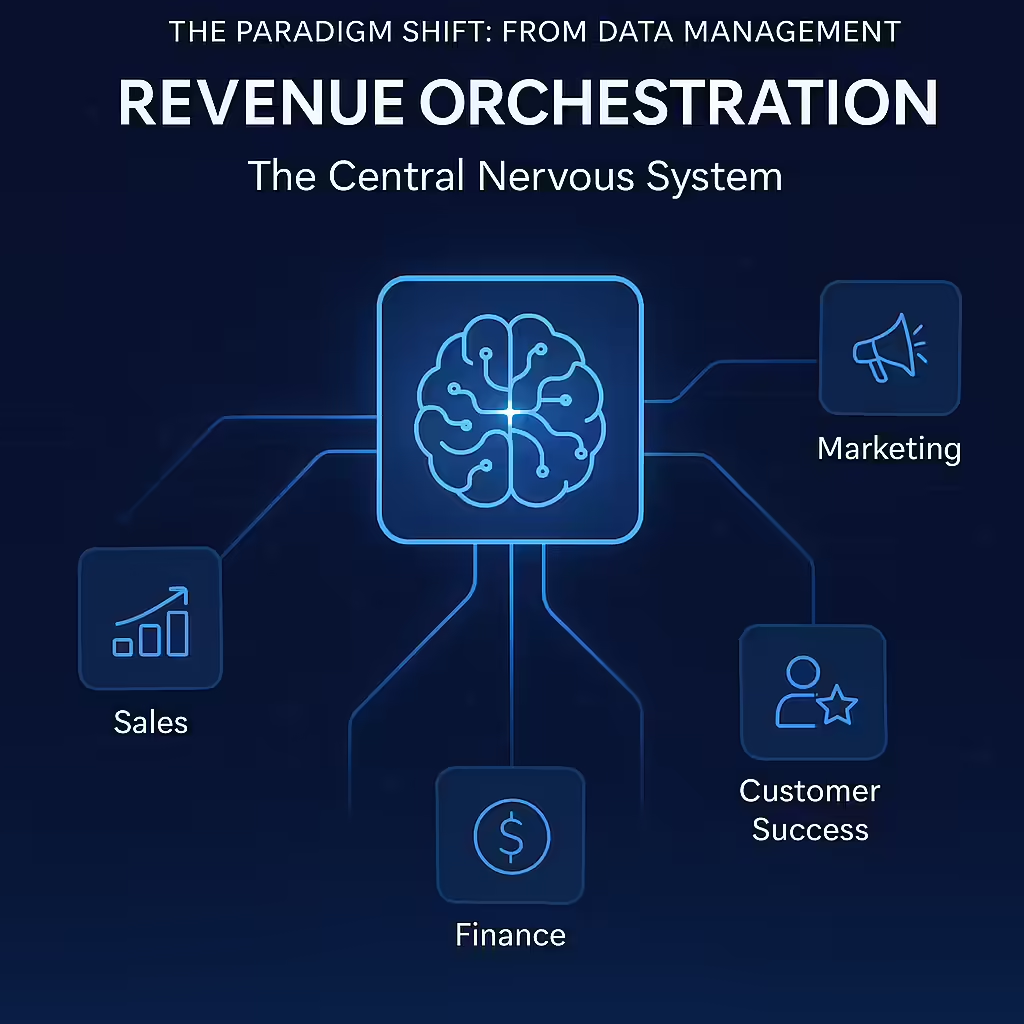
Defining Revenue Orchestration: The Central Nervous System
A Revenue Orchestration Platform (ROP) is a revolutionary technology designed to manage the complexities of modern sales by acting as the “central nervous system” of the entire revenue engine. It connects and coordinates the once loosely connected parts of the business—sales, marketing, customer success, and even finance—into a single, unified powerhouse. Lending third-party credibility to this concept, Forrester analysts state that ROPs “enable B2B organizations to orchestrate and maximize commercial performance” across the entire customer lifecycle, from new logo acquisition to renewal and expansion. This is not just about sharing data; it’s about harmonizing processes, goals, and actions to create a seamless and efficient revenue motion.
Beyond the CRM: The “Single Pane of Glass” and More
While providing a “single pane of glass” view is a foundational capability of an ROP, this is merely the starting point. The true paradigm shift lies in moving from a passive system of record, like a traditional CRM, to an active system of engagement and intelligence. An ROP achieves this by unifying a suite of critical technologies—such as sales engagement, conversation intelligence, deal management, and forecasting—into one cohesive platform. This integrated approach directly solves the “point solution puzzle” that plagues so many organizations, reducing tech bloat and eliminating the data silos that arise from a fragmented stack.
The value of this shift becomes clearest when contrasting the old, reactive way of operating with the new, proactive approach enabled by orchestration.
| Leadership Challenge | The Old Way (Fragmented & Reactive) | The Revenue Orchestration Way (Unified & Proactive) |
|---|---|---|
| Forecasting Accuracy | Guesswork based on stale, manually-entered CRM data and rep sentiment. | AI-driven models using real-time buyer signals and rep interaction data for data-driven, predictable forecasting. |
| Team Performance | Coaching based on anecdotes and lagging indicators. Inconsistent training and unclear goals. | Data-backed coaching on proven winning behaviors identified from call analysis. Enforced best-practice workflows. |
| Pipeline Health | A black box understood through time-consuming, manual report-pulling. Blind spots from poor data hygiene. | A real-time, “single pane of glass” view with AI-flagged deal risks and automated data capture. |
| Process Efficiency | Manual, repetitive tasks, data entry, and chasing updates across siloed teams, leading to errors and delays. | Automated workflows, data synchronization, and streamlined communication across the entire GTM team. |
| Strategic Planning | Reactive fire-fighting and decisions based on incomplete, outdated information. | Proactive strategy based on a clear, holistic view of what drives revenue, enabling agile responses to market changes. |
Adopting this orchestrated approach represents a profound change in organizational philosophy. It dissolves the traditional departmental silos that have long hindered growth. In a typical organization, sales, marketing, and customer success operate with misaligned goals and metrics. Marketing is judged on lead volume, sales on closed deals, and customer success on retention rates. This often creates an “us vs. them” culture where teams work at cross-purposes.
Revenue Orchestration dismantles these walls. By creating a shared data reality and unified workflows, it compels these disparate groups to operate from the same playbook, as a single, cohesive “Revenue Team”. The “single source of truth” means marketing can finally see which campaigns generate actual revenue, not just clicks. Sales gains crucial context on a lead’s entire history of interactions. Customer success understands the exact promises made during the sales cycle, enabling a smoother handoff and a better customer experience. Therefore, the decision to implement an ROP is not merely a technological one; it is a strategic leadership decision to restructure how the entire company pursues and thinks about revenue, fostering a powerful culture of shared accountability and aligned purpose.
The Engine of Action: How Orchestration Translates Data into Decisions
The true power of Revenue Orchestration lies in its ability to move beyond passive visibility and actively guide the entire revenue team toward the right actions. It is the engine that translates raw data into intelligent, timely, and context-aware decisions at every level of the organization. This transformation is powered by a sophisticated AI layer that acts as the bridge between seeing what is happening and knowing what to do about it.
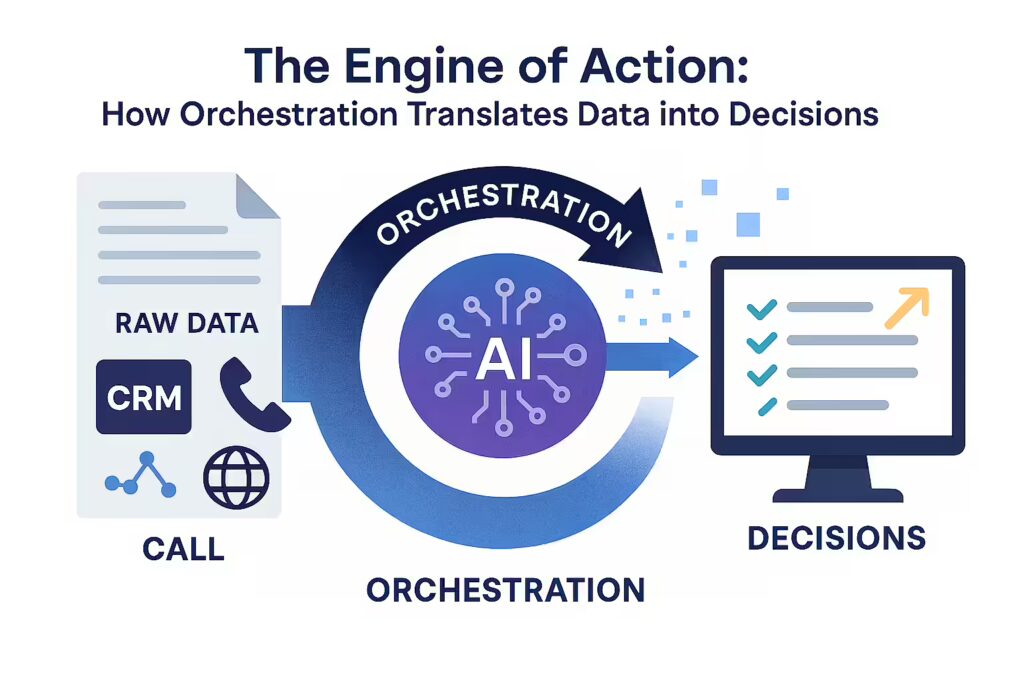
The AI-Powered Translation Layer
The “magic” of a Revenue Orchestration Platform is its use of Artificial Intelligence to analyze and synthesize millions of disparate data points in real time. This includes every buyer and seller interaction, every call recording and email, all CRM data, and a constant stream of buyer signals from across the web. Crucially, this AI does not simply present this data in a new chart or dashboard. Its primary function is to serve as a translation layer, providing what Forrester analysts call “structured and unstructured (or dynamic) guidance on what to prioritize next”. It is this capability that truly connects insight to action, transforming the platform from a system of record into a system of guidance.
For the CRO/CFO – From Guesswork to Governance
For senior leadership, orchestration provides the tools for confident governance and strategic oversight.
Predictable Forecasting: The platform’s AI-driven forecasting models move far beyond rep-submitted estimates. By analyzing real-time deal health, the sentiment and frequency of buyer engagement, and historical performance data, the system builds an informed, achievable revenue plan. This provides the C-suite with a data-backed forecast they can trust, directly addressing the critical visibility gap that prevents 55% of CFOs from providing effective strategic guidance.
Pipeline Integrity: ROPs act as a crucial governance layer for the entire revenue process, ensuring that high-quality, structured data flows into the CRM and that established processes are consistently followed. This tackles the pervasive problem of poor data hygiene that cripples visibility from the ground up. The system can automatically flag risks in the pipeline—such as deals that have stalled, lack engagement from key decision-makers, or are not being multi-threaded—allowing leadership to intervene proactively before a deal is lost.
For the VP of Sales – From Anecdotes to Scalable Excellence
For sales managers, orchestration turns the art of sales management into a science.
Data-Driven Coaching: Conversation intelligence and performance analytics provide managers with unparalleled visibility into what their teams are actually doing and saying on calls. They can move beyond anecdotal feedback and pinpoint the specific behaviors of their top performers—the questions they ask, the language they use, their talk-to-listen ratio, and how they successfully navigate objections. This data allows managers to create highly targeted coaching programs and build best-practice workflows that can be scaled across the entire team. This makes coaching far more efficient and impactful, solving the challenge of a time-consuming but essential activity that is directly linked to quota attainment.
Improving Sales Scripts & Talk Tracks: A tangible example of turning visibility into action is the refinement of sales scripts. By analyzing call recordings and their associated outcomes, managers can use data to improve messaging. They can track metrics like call duration, success rates for different opening lines, and conversion data related to specific value propositions to make data-driven decisions about what works. This transforms the script from a static document into a living playbook that is continuously optimized based on real-world feedback.
For the Head of RevOps – From Chaos to Optimized Process
For Revenue Operations, orchestration provides the clarity and automation needed to build a truly efficient revenue machine.
Process Bottleneck Identification: A unified, end-to-end view of the revenue motion allows RevOps leaders to see exactly where processes are breaking down. They can identify issues like slow lead follow-up times, inefficient lead routing, or poor handoffs between sales development reps (SDRs) and account executives (AEs) that would otherwise be hidden within departmental silos.
Workflow Automation: A core function of an ROP is the automation of countless manual and repetitive tasks. This includes lead-to-account matching, activity logging, and data entry, which can save teams hundreds of hours per week and dramatically reduce the risk of human error. This frees the RevOps team from a constant state of manual data clean-up, allowing them to focus on high-value strategic initiatives and continuous process improvement.
This system of actionable intelligence creates a cascading effect of alignment throughout the organization. At the macro level, a CRO might see an AI-generated forecast risk and decide to launch a targeted incentive program for late-stage deals. This is a top-down strategic action. At the meso level, a VP of Sales might use conversation intelligence to discover that reps are struggling with a new competitor’s objection and respond by creating a new battle card and running a team-wide coaching session. This is a tactical, managerial action. Finally, at the micro level, the ROP prompts an individual rep directly in their workflow with a “next best action,” such as, “This deal is stalled. Engage the VP of Engineering with this specific email template”. True revenue orchestration ensures these three levels of action are perfectly aligned, translating top-level strategy all the way down to every individual customer interaction.
The Kixie Foundation: Powering Orchestration with Perfect Interaction Data
A Revenue Orchestration Platform, with its sophisticated AI and analytics, is a powerful engine. But like any engine, it is useless without high-quality fuel. The entire intelligence layer of an ROP is utterly dependent on the quality, timeliness, and completeness of the data it ingests. The most valuable and predictive data does not come from static fields; it comes from the dynamic, two-way interactions that happen between your team and your customers every single day. This is where Kixie provides the indispensable foundation for any successful orchestration strategy.
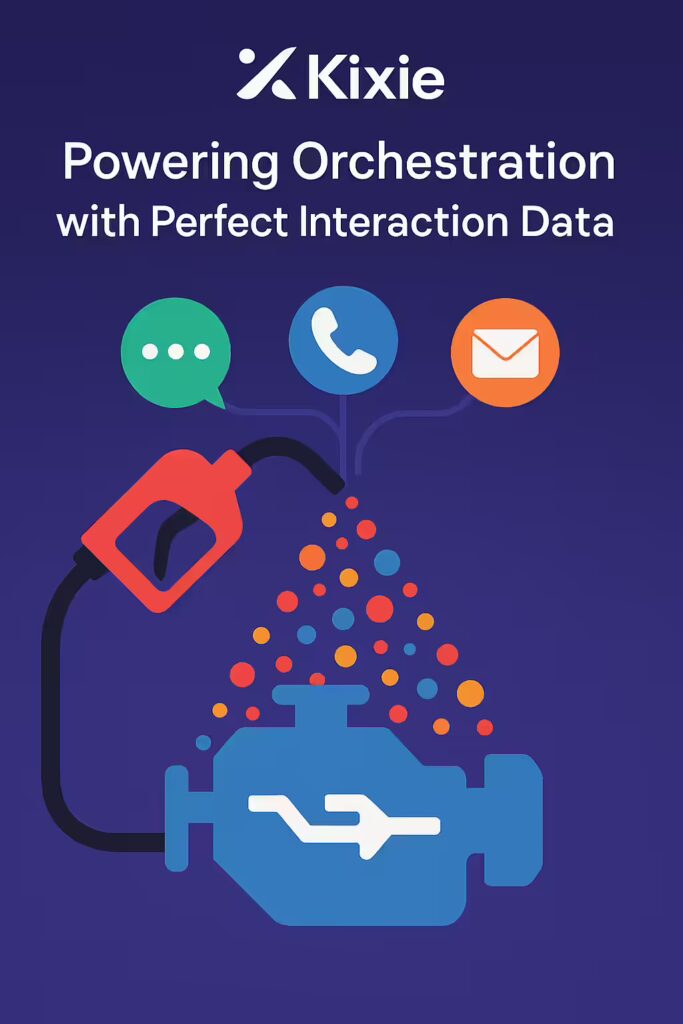
Orchestration Needs Fuel: The Critical Role of Interaction Data
Kixie is the system that captures the highest-fidelity signals at the point of engagement. Every call placed, every text message sent, every connection made, every conversation’s duration, and every call’s outcome is a critical piece of data. This is the raw material that orchestration platforms refine into strategic insights. Without a reliable and automated way to capture this interaction data, any ROP will be running on incomplete information, leading to flawed analysis and misguided recommendations.
Kixie as the Single Source of Truth for Engagement
The core mechanism that makes Kixie a foundational element is its deep, bi-directional integration with major CRMs like HubSpot and Salesforce. This integration is the pipeline that creates a single source of truth for all engagement activity. Kixie automatically logs every interaction with precise, structured data—distinguishing between an “Answered Call,” a “Missed Call,” or an “sms outgoing” without requiring any manual data entry from the sales rep. This automated process solves the chronic problem of poor data hygiene at its source. It ensures the ROP is fed a constant stream of clean, reliable, and perfectly structured data, which is essential for its AI models to function accurately.
From Visibility to Action within the Kixie Platform
Kixie is more than just a data capture tool; it is a platform for both visibility and action, enabling teams to execute on an orchestration strategy.
Visibility: For management, Kixie provides a real-time pulse on team activity. The Reporting Dashboard, Live Call Board, and Sales Leaderboards offer an immediate, live view of performance. A manager can see exactly who is on a call, which contact they are speaking with, and how key metrics like call volume and connection rates are tracking against goals, all in real time.
Action: For reps on the front lines, Kixie provides the powerful engagement tools needed to execute their outreach with maximum efficiency. Features like the AI-powered PowerDialer with Human Voice Detection, which automatically connects reps only to live people, along with Local Presence dialing to increase connection rates and one-click Voicemail Drop, are the very instruments they use to act on the priorities identified by the overarching orchestration strategy.
This creates a powerful, symbiotic relationship. Kixie’s engagement tools generate the raw interaction data. Kixie’s seamless integration pipes that clean data into the CRM. The Revenue Orchestration Platform’s AI analyzes that data to generate insights and priorities. The ROP then pushes those prioritized actions back to the rep. Finally, the rep uses Kixie’s best-in-class engagement tools to execute those actions with speed and precision.
This integrated workflow effectively democratizes data-driven action. A major challenge in implementing any new strategy is driving behavior change across the sales team. Reps are often resistant to new tools that add clicks or force them to leave their primary workspace. Kixie solves this by making the process frictionless. Features like click-to-call from within the CRM and fully automated activity logging mean the “data capture” part of the process is invisible to the rep. When the strategy dictates “call these ten high-priority leads,” the rep simply loads them into a Kixie PowerList and executes, without ever switching systems. By making the data-driven workflow the path of least resistance, Kixie dramatically increases the likelihood of a successful ROP implementation, ensuring the strategic plan conceived in the boardroom is flawlessly executed on the front lines.
The Bottom Line: The Quantifiable ROI of Orchestrated Action
Ultimately, any strategic shift must be justified by its impact on the bottom line. For C-suite executives and budget holders, the decision to invest in a Revenue Orchestration strategy is validated by overwhelming evidence of tangible financial results. The ROI is not abstract; it is measured in increased revenue, improved efficiency, and higher win rates.
Presenting Overwhelming Proof
The financial impact of adopting an orchestrated approach is well-documented. A comprehensive Total Economic Impact™ (TEI) study conducted by Forrester Consulting on a leading Revenue Orchestration Platform quantified staggering results for a composite enterprise organization. The study found the platform delivered a 3.3x return on investment (ROI), a 12% increase in closed-won rates, and generated $12.4 million in profit gains directly tied to better response and conversion rates.
These remarkable figures are supported by a wide range of case studies across various industries, demonstrating the broad applicability of the orchestration model:
Accelerated Top-Line Growth: Paycor, a human capital management company, leveraged revenue intelligence to achieve a 141% surge in upsell deal wins. Salesloft customers were able to generate 2.5x more pipeline and sales opportunities. A manufacturing company that implemented a more strategic, orchestrated engagement process saw a 299% increase in revenue from those efforts alone.
Dramatic Efficiency Gains: The automation and process optimization inherent in orchestration translate directly into time saved. Allianz Trade saved its sales reps 15 hours per week, freeing them to focus on selling. The data company Alation saved 25-30 hours of manual work per week by automating lead routing processes. Other providers cite overall 30% productivity gains across the revenue team.
Improved Conversion and Engagement: An orchestrated approach ensures that reps are focused on the right activities with the right message. This leads to a 50% higher conversion rate from initial engagement to qualified opportunity and a 20% increase in buyer response rates. Ultimately, this translates to more reps hitting their targets, with companies reporting a 20% increase in quota attainment.
Connecting ROI to Orchestration
These numbers are the direct result of the principles discussed throughout this analysis. The 12% increase in close rates is not magic; it is the outcome of providing managers with conversation intelligence to deliver better, data-driven coaching. The 15 hours saved per week is the tangible benefit of automating manual data entry and reporting. The 141% surge in wins is due to AI-powered pipeline management that focuses reps on the deals most likely to close and guides them on the next best steps. This is proof that the investment is not merely in a piece of software, but in a more intelligent and efficient process for generating revenue.
The return on this investment is not a one-time lift but a compounding effect. It creates a “flywheel” that accelerates over time. The initial implementation automates tasks and cleans up data, providing immediate efficiency gains. This clean, automated data then feeds the AI engine, which begins to surface more accurate insights about what is working. These insights lead to better coaching and more effective rep actions, which improves win rates and deal velocity. These improved outcomes, in turn, generate even more high-quality data—more examples of winning calls and successful talk tracks—which further refines the AI model. This creates a virtuous cycle where the system gets smarter, the reps get better, and the entire revenue engine accelerates with each rotation. This is the “flywheel across both the buyer and seller journey” that defines a modern, orchestrated approach. The investment is not in a static cost center, but in an appreciating, self-improving asset.
Lead with Certainty
The modern revenue leader stands at a crossroads. One path leads deeper into the visibility crisis—a world of fragmented data, reactive fire-fighting, and high-stakes guesswork. The other path leads to a new way of operating, defined by clarity, alignment, and precision. This is the path of Revenue Orchestration.
The journey begins by acknowledging that leadership is broken not by a lack of data, but by a lack of clarity. The solution is to adopt a new strategic philosophy that harmonizes people, processes, and technology into a single, unified revenue engine. This engine is powered by AI that translates passive visibility into intelligent, tiered action, guiding everyone from the CRO to the frontline rep. The result of this orchestrated approach is not just incremental improvement, but transformative, quantifiable growth, proven by a massive return on investment.
In an era defined by economic uncertainty and intense competition, the ability to orchestrate your revenue engine with data-driven precision is the ultimate competitive advantage. It is the difference between reacting to the market and leading it. It is the key to evolving from a leadership team that says, “I think we’ll hit our number,” to one that can declare with confidence, “I know how we will hit our number.”
Building a true revenue orchestration engine starts with a flawless data foundation. The highest-quality insights are derived from the highest-quality interaction data. See how Kixie provides the real-time engagement and automated data capture you need to turn visibility into decisive action.


